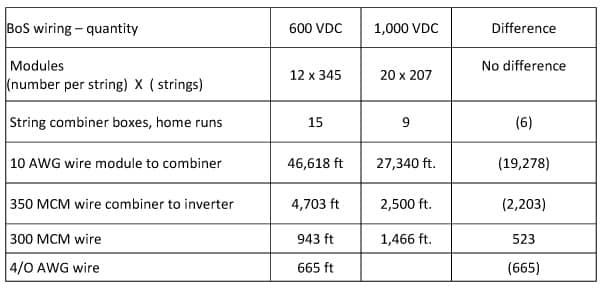The U.S. commercial PV market is primed for significant growth. According to GTM Research and the Solar Energy Industries Association, the segment is expected to see a 25% annual compound growth rate from 2011 to 2016, clearly indicating the market's potential.
{OPENADS=zone=20&float=right}
While much of the growth has been attributed to plunging module prices, a new focus on inverter technology and design innovation in balance-of-system (BOS) components promises to drive the generated cost of solar electricity even lower.
BOS pricing can be relatively inflexible due to raw material costs. However, there is room for savings through new technologies and system design optimization. One such innovation, which is already applied as a standard best practice in the European commercial segment and utility projects around the world, has recently entered the North American commercial market: 1,000 V DC design.
Utilizing 1,000 V DC input design and technology allows integrators to realize increased energy production, material cost savings and a lower levelized cost of energy.
The barriers to domestic adoption of 1,000 V DC designs have ranged from a lack of high-quality UL listed products, legacy designs at 600 V DC and reluctant inspector acceptance.
Recently, however, the tide has changed, and these barriers have been removed by a growing number of high-quality UL-listed modules, BOS components and inverters driven mainly by the utility segment, along with a greater awareness among inspectors that provisions exist in the current code to support 1,000 V DC for commercial applications.
Clear financial benefits
The case for commercial 1,000 V DC adoption is clear. With higher voltages, integrators benefit from lower installed costs, greater inverter efficiency, less system power loss and a reduced number of BOS components.
For comparison, consider the following benchmark between a traditional 600 V DC system and a 1,000 V DC system:

Due to greater DC input and longer DC strings, the reference system achieves significant savings, particularly attributed to reduced wiring need. The following graph illustrates these savings:

By saving more than 19,000 feet of 10 AWG wire and 2,000 feet of MCM wire and cabling, the 1,000 V DC system saved more than $20,000 on wiring costs alone, not including conduit or labor savings. When all factors are considered, a $0.02/W to $0.03/W savings can be achieved at installation.
Improved performance
Systems can achieve additional savings through better performance. Reduced line losses and higher inverter efficiency improve energy production, reducing the system's cost-per-megawatt hour.
Following the principle that higher voltages will experience less resistance, a 1,000 V DC system will perform better than a 600 V DC system. Comparing line losses through a voltage drop calculator showed the following for the same 750 kW AC example:

With an approximate 0.5% efficiency gain due to lower line loss, total energy harvest is improved.
The same principle applies within the inverter. Higher voltage means less internal resistance. The current CEC efficiency record is 98.5%, held by the SMA Sunny Central 800 CP-US inverter – a 1,000 V DC machine.
In comparison, the efficiencies of most 600 V DC inverters will be 0.5% to 1% lower. Designers work very hard to find efficiency gain because they know it translates directly into a more profitable project.
Long-term financial advantage
How much is a 1% gain worth to a project this size? We compared five sites across the U.S., using PVsyst, a PC software package for the study, sizing, simulation and data analysis of complete PV systems.
Using the program's default values, PVsyst showed that the 1% gain could be worth more than $40,000 over 20 years at $0.12/kWh. Columbus, Ohio – the ‘least valuable’ of the five sites – showed a value of $28,000 while Tucson, Ariz., came in at more than $40,000.
With approximately 40% BOS wiring savings and up to 2% efficiency improvement, the economic value can top $100,000 per MW/DC ($0.10/W). This is exactly why 1,000 V DC systems have been the preferred standard in Europe for several years.
This technology and design standard has ability to appreciably drive price down and value up in North America. With code, inspector and equipment supply issues resolved, the future of 1,000 V DC domestic commercial PV is extremely promising.
For more information on leading 1,000 V DC system design, visit the SMA Sunny Central CP-US Application Guide.
Jim Morgenson is director of business development for power plant solutions at SMA America. For more information, please contact sales@SMA-America.com.

